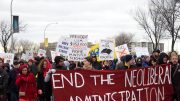This year, Winnipeg’s labour community marked the 90th anniversary of the Winnipeg General Strike. 2009 also marks the 75th anniversary of a less well-known, but politically significant moment in Winnipeg’s history. It was on Nov. 23, 1934 that, for the first time in the city’s history, labour parties elected more representatives to city council than their pro-business opponents. In a city still sharply split along the labour-business divisions of the General Strike, the victory was described in the Free Press as “nothing less than a bombshell to many citizens.” John Queen, who had been jailed for seditious conspiracy for his role in the 1919 strike, became mayor of the city.
After the General Strike ended in 1919, several of its leaders sought to address the societal inequities they saw through the political sphere. In particular, efforts were made to make inroads in municipal politics, with candidates running under such mottos as “humanity first, not property.” In November 1934, the Independent Labour Party (ILP), the largest local labour party, ran a campaign to “protect the people in humble circumstances.” It was able to build on opposition to an unpopular report that was supported by most pro-business candidates and, for the first time ever, labour politicians gained control of city council.
Taking advantage of its slim majority on council, labour council members quickly sought to reform the city. First, in what they said was an attempt to stop tax increases on the poor, they sought to drastically increase business property taxes, which at the time were the lowest in the country. However, they also hoped to impose taxes on a sliding scale so that small businesses would pay less tax, while banks, department stores and other large businesses would find their tax bill increased six-fold.
Naturally, this raised the ire of larger businesses, which fought the move when it went to the province for approval. In the end, the province forced a compromise. Taxes increased from six and two-thirds per cent to a maximum of 15 per cent (with a minimum of five per cent) depending on the type of business, nearly doubling the city’s revenue from business taxes.
It seems quaint now that, in a city such as Winnipeg, the introduction of the universal franchise is a relatively recent thing. Labour politicians had long fought for a “one man, one vote” system to replace a system in which only those with property could vote and in which those with multiple properties could vote multiple times. Despite significant opposition from the business community (which referred to it as “an attack on property rights”), city council passed a universal franchise bylaw with the vote divided along labour-business lines. The provincial government later vetoed the bylaw.
Perhaps the biggest difference between the labour aldermen and their pro-business opponents was the treatment of the unemployed. At the time, unemployment relief was a municipal responsibility, and was a particular point of contention in the city. The difference of opinion was stark — John Queen referred to the unemployed as “the best of citizens” while business groups argued that unemployment relief merely resulted “in a tremendous reduction of individual initiative.”
Upon assuming office, the labour councilmen demanded that the relief department be “humanized.” To do so, they provided dental and optical care for the unemployed, provided increases in food rations, and established relief depots throughout the city, which eased transportation difficulties for the unemployed. Nearly all these measures were won by slim margins — with the vote split precisely along labour-business lines.
There were certainly some difficulties that the labour councilors faced. For one, there were frequent disagreements between communists and members of the ILP, although the two often voted similarly on council motions. Secondly, many pieces of legislation required provincial approval, something that a conservative provincial government was not likely to provide. Labour councilors often ended up arguing with union allies, who were frustrated by the pace of reform and the inability of the city to provide more assistance. And finally, as one of their opponents pointed out, it was “absolutely impossible” under the economic conditions of the 1930s to “turn the city hall upside down.” Desires for reform were tempered by an understanding of the financial limitations facing the city. Labour would maintain its majority and the mayoralty in the elections of 1935, but would lose them both in 1936.
Despite the relatively short period that labour politicians held a political majority on Winnipeg’s city council, it is in many ways the culmination of an effort to win control of local power structures that began with the General Strike and shifted into the sphere of municipal politics. You won’t see any murals downtown for the city council that was elected in 1934 — but it too was a significant moment in the history of left-wing politics in Winnipeg.
Stefan Epp is a researcher at the University of Manitoba. He has an MA in history, which focused on Winnipeg in the 1930s.




